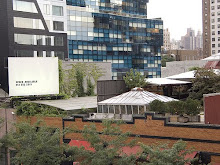

 1) Archival Image of Avenue D and East 10th Street, Manhattan (March 23, 1937)
1) Archival Image of Avenue D and East 10th Street, Manhattan (March 23, 1937) Address: North side of E. 10th Street between Ave. C & Ave. D, at Szold Place
Directions:
· Take the M14D to 10th Street between Avenue C and D.
· Take the L train to the 1st Ave Street Station.
· Take the L, N, Q, R, W, 4, 5 to Union Square, Take the M14D to 10th Street and Avenue D.
An important site in the landscape of the Lower East Side, the Dry Dock Playground and Pool—also known as Szold pool—sits at a dynamic crossroads amidst changing forces in this Manhattan neighborhood. Positioned with the Con Edison East River generating station to its North, and Louisaida Avenue C to its West, the sprawling Lilian Wald and Jacob Riis Housing Projects flank it East to South. This recreational area serves as a dynamic meeting-place for schoolchildren, teens, families, and longtime neighborhood residences of varying races and national origins.
Located in an area once known as the Dry Dock District—a name given in the mid 19th-century after its booming iron works industry—the City of New York acquired the land in 1964 as part of the Thompsons Square Urban Renewal Area Project. The Pool and Park were opened in 1975 as a part of a neighborhood wide effort to clean up the local tenement buildings, warehouses, and abandoned facilities. Because of the pool’s proximity to the Wald and Riis Houses, and its shared servicing of the ever-gentrifying Louisida Avenue C, the space around the pool has arisen as new epicenter in the divide of class and racial polarization.
In 1990 the city invested $500,000 in renovating the pool and park; putting up new fences, benches, play equipment, new basketball backboards, repaving the cement, and re-building curbs. Again, similar to the conditions surrounding its inception, this was part of a larger effort to clean up the neighborhood. Since the Lower East Side exists as one of the last ‘urban ethnic enclaves’ in Manhattan, a highly controversial emerging power struggle can be observed in the blocks surrounding the Dry-Dock Pool. It is suspected by neighborhood residence and business owners that developers have been eyeing the prime stretch of waterfront real estate that runs along Avenue D for a while now, however there remains one epic hurdle preventing them from transforming the space into luxury condos or office space; nearly 9,000 people reside in the Lilian Wald and Jacob Riis houses. Although these plans of redevelopment are not official, residents fear that one day they will be forced out, with no affordable alternative. This worry is not contained to only Wald and Riis housing residents, it comes as part of a larger epidemic, and a New York City affordable housing shortage. “Citywide, there is an eight year waiting list for public housing,” Arlene Davila reveals in Barrio Dreams, “more than 224,000 households are waiting to receive Section 8 vouchers to subsidize their rents, while one quarter of New Yorkers spend more than half of their income on rent.” With a deep-rooted culture woven in this early immigrant neighborhood, huge concerns remain for residence, housing officials, and neighborhood prospects. This 'final frontier' of Lower Manhattan has created an explosive power dynamic, and perched amidst the debates, the Szold's pool remains a staple of the neighborhood and a forced meeting-place for new and old residents alike.
Daivila, Arlene. Barrio Dreams: Puerto Rican, Latinos, and the Neoliberal City. Page 29. Berkeley and Los Angeles, California. University of California Press, 2004. Paperback.
Gates, Jennifer A. Strangers in New York: Ethnic tourism as commodity, spectacle, and urban leisure in three Manhattan neighborhoods.
Martinez, Miranda J. The struggle for gardens: Puerto Ricans, redevelopment, and the negotiation of difference in a changing community.

No comments:
Post a Comment